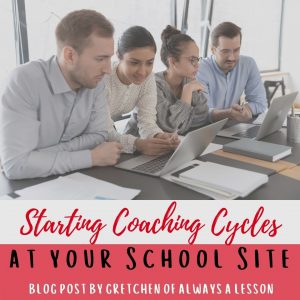Starting Coaching Cycles at your School Site
Coaching cycles are a way for instructional coaches to individually support classroom teachers. The role of an instructional coach is to guide the growth and development of teachers. Coaching cycles provide a roadmap instructional coaches can follow to keep teachers on the growth trajectory. This post will share how to get started with coaching cycles at your school site.
 Background Information on Coaching Cycles
Background Information on Coaching Cycles
A cycle refers to the repeated process of meeting, observing and serving teachers. For example, a simplified coaching cycle could look like a trio observation: pre-observation, observation, and post-observation debrief. This simplified cycle can easily be extended by adding goal setting meetings, professional development sessions, peer observations, tape recording and reflection exercises, etc. (These options could be outlined in a coaching menu like this one.)
There are generally two tracks in the coaching cycle model: on and off-track. On-track means the teacher is receiving the right amount of support resulting in an increase in their skill set. These teachers can graduate out of the coaching cycle model to a more hands-off approach like short, pop-in classroom visits and ad hoc meetings to brainstorm or answer questions. If an instructional coach needs to provide more ongoing or intensive support to a teacher, they will employ the off-track model. This means they continue to repeat the extensive coaching cycle until the teacher improves.
No matter which coaching cycle is utilized, the goal is the same: improve the skill of the teacher and achievement of the student.
Get Organized
Now that you have a better understanding of coaching cycles, it’s time to plan your own. Getting organized is a great first step. Grab your teacher roster and note which teachers would be willing participants and which are assigned to you from administration. These two groups of teachers will enter your coaching cycles first. Then, you’ll want to survey them to find out their skill level (Here’s a survey example.) This information will help you determine where they view their own skill set and what areas they want to strengthen.
Are you in need of other beginning of the year coaching resources? Click here.
Set the Stage
After getting organized, you’ll want to set the foundation for coaching. This is an opportunity to meet with teachers to introduce yourself and your role. Walk teachers through the coaching cycle model, explaining the purpose of each support. You might even want to model portions as necessary. Don’t forget to allow teachers to ask questions.
It’s important to note, when beginning coaching cycles, you will build the process slowly. For example, for the first month to month and a half, you’ll simply plan with teachers and observe them. You will not complete a full cycle until month two and beyond. This allows time to build relationships and rapport with the teacher and students in the classrooms you are visiting.
Dive in
Wahoo! It’s time to dive in and begin working hard with teachers. You’ll move from building relationships and establishing a presence in classrooms to fully partnering with teachers. Your initial planning meetings with teachers will help you know who is in your cycle, which intensive model they are partaking in, and where they are within the cycle framework. It might be helpful to have the coaching cycle visual enlarged and placed on a wall. You can use post-its with teacher names or notations to easily move them through the cycle.
You can now begin mini or whole group coaching sessions as well as professional development and practice rounds. When you notice common trends among staff you can address the whole roster of teachers. When you notice similar struggles among individual teachers, you can bring together smaller groups to focus on those areas. Most importantly though, practice should be essential in your support options for teachers. Running drills during practice helps teachers build muscle memory. Acting out specific teaching skills repetitiously increases the likelihood the skill will translate into the classroom.
Next Steps
-
- Design your varied coaching cycle tracks from less to more intensive models
- Get yourself and your space organized
- Meet with teachers to explain all of the partnership opportunities (grab an example coaching cycle visual and all observation forms...or just snag the entire instructional coaching binder)
- Start working with teachers!
Coaching cycles are a fantastic way to help teachers get better faster and in a more focused way. The hard work between the teacher and yourself will pay off!
Get access to more instructional coaching resources and professional development resources below:
Go Be Great!
How do you start your coaching cycles?



